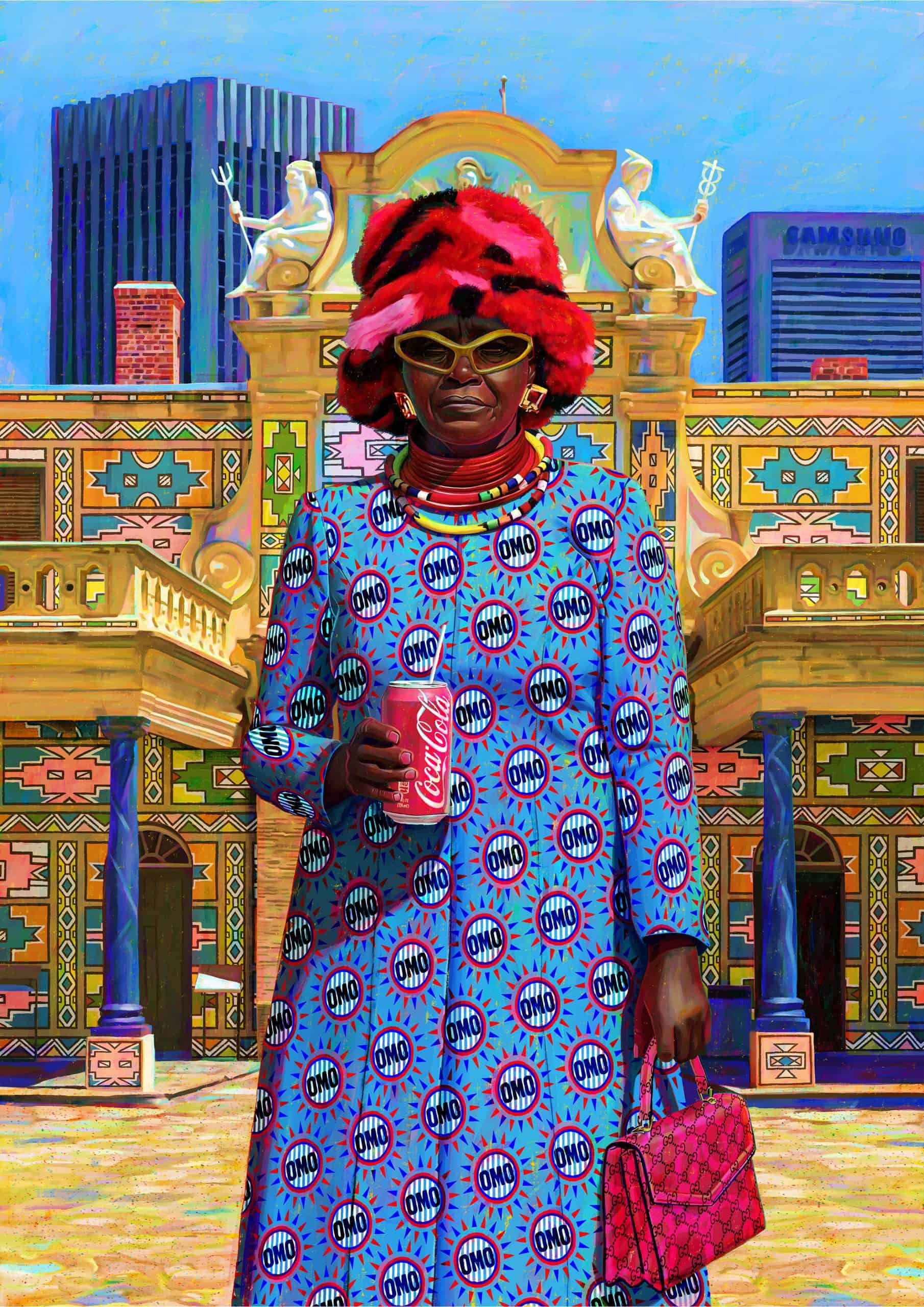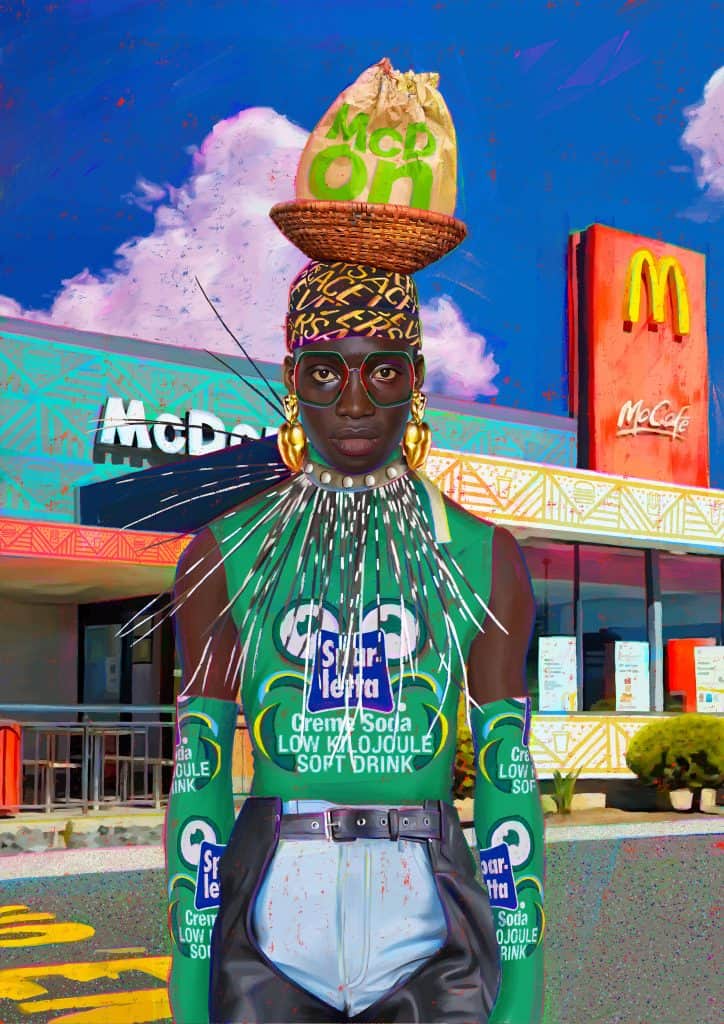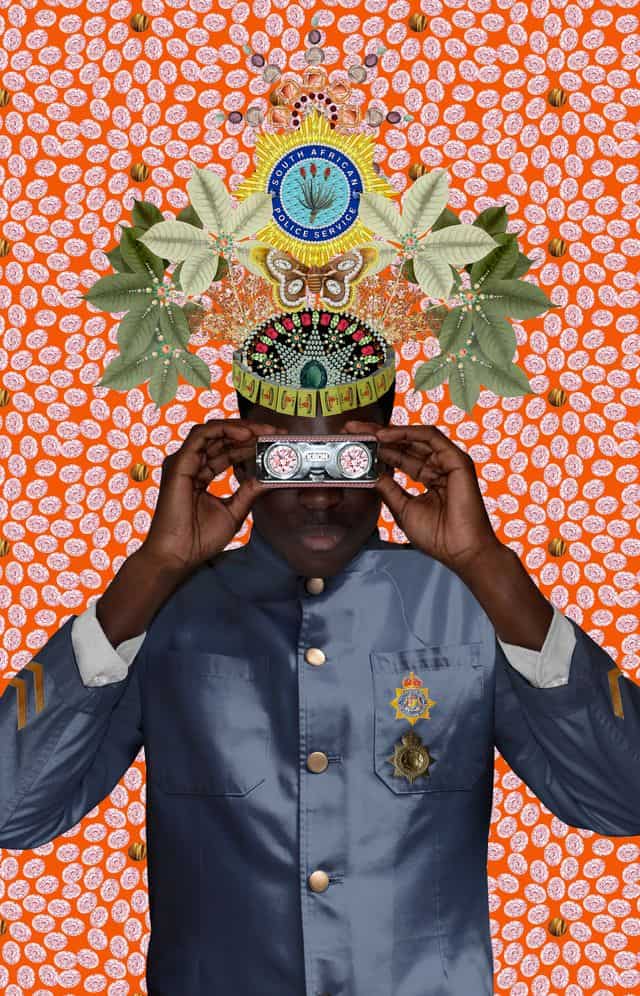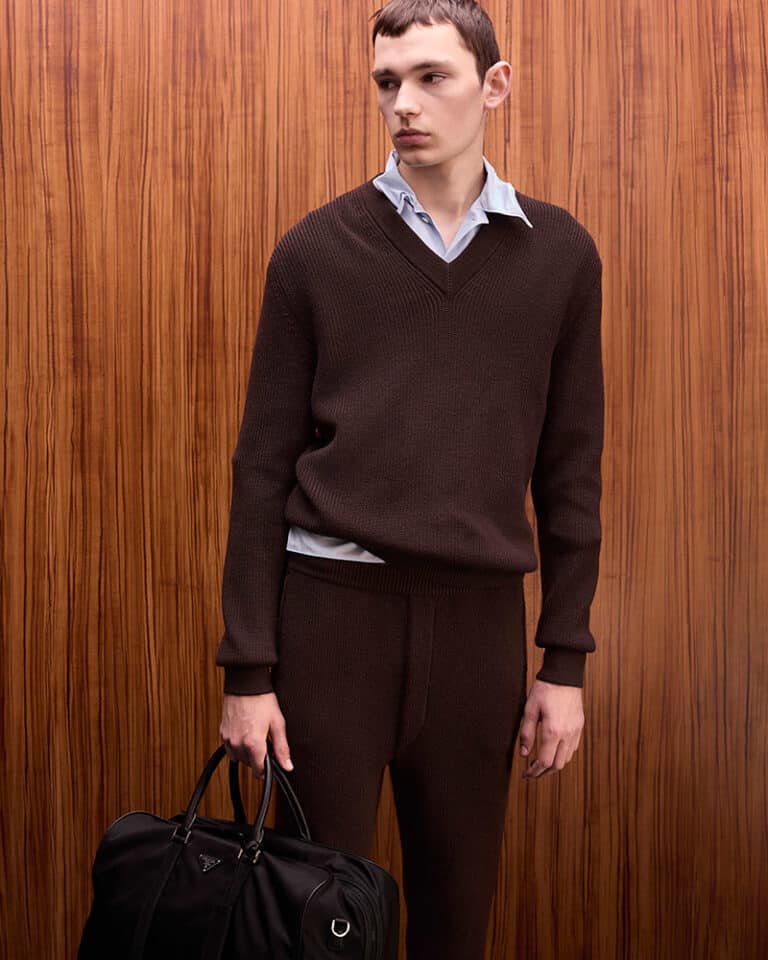
RUAN JOOSTE A CREATIVE EVOLUTION
Anji Connell
Ruan Jooste, a Cape Town-based South African artist, creates vibrant art that explores themes of identity and memory. His work is deeply influenced by South African branding and colour. By using logos and prints, he evokes nostalgia. Fostering universal connections through shared cultural symbols, encouraging a sense of unity. Each emblem serves as a portal to personal memories, illustrating how people can bond over familiar brands. Jooste’s art blends real stories with dreamlike elements, enhancing its emotional resonance. He believes that, despite cultural differences, themes like joy, resilience, and storytelling are universally relatable. He celebrates the unique aspects of South African life. Inviting viewers from diverse backgrounds to find their own connections to the shared human experience.
Jooste brings his hand-drawn digital artworks to life by intricately weaving the stories of both known and unknown individuals into his pieces. His art reflects a deep connection to identity and resilience. Drawing inspiration from the bustling streets of his homeland and universal human experiences. With each artwork, he encourages viewers to look beyond the surface, sparking curiosity about the lives that inspire him. In our conversation, we delve into the heart of his creative process. Exploring the captivating stories that fuel his artistic vision.
Recently, Jooste made a significant transition from a career in fashion photography to pursue art full-time.



IRK: Ruan what inspired you to make the leap from being a fashion photographer to a full-time artist?
Ruan: Art has always been an essential part of my identity. Ever since I could hold a pencil, I have been drawing. My passion for art has consistently influenced my life, whether through fashion, photography, or visual storytelling. However, it wasn’t until the pandemic that I found the time and space to truly reconnect with my artistic side. During the lockdown, creating art helped me stay grounded and occupied my mind. Deep down, I have always known that being an artist is my true calling. It was just a matter of rediscovering the right path.
IRK: I’m curious to know what draws you to logos and colour in shaping your artistic narrative. Does this connection stem from your fashion background?
Ruan: I’m drawn to prints and logos because they add layers of meaning to my work. South African branding, in particular, plays a significant role—it’s familiar, nostalgic, and deeply tied to memory. Something as simple as Lucky Star pilchards can instantly transport people to a specific moment in their lives. What fascinates me is that each of us has our own version of that memory.
Lucky Star reminds me of my dad. He was the only one in our house who ate them, always on a piece of toast. Using branding in my art reflects the idea that, despite coming from different backgrounds, cultures, and religions, we all grew up with specific brands that have become part of our identities. These brands are part of our shared cultural fabric, holding stories within them that highlight how connected we really are.
I also enjoy mixing well-known fashion labels with local iconography. As it creates a playful contrast and adds a touch of elevation to the everyday. This blend likely reflects both my fashion background and my personality. I love the idea of creating work that feels both fun and meaningful.
Colour plays a big part in that, too. It’s a way to celebrate our rainbow nation, to be bold, expressive, and full of joy. Ironically, I tend to be more reserved with colour in my own life. So perhaps bringing that energy into my work is a way of inviting more of it into my world.

IRK: Would you describe your work as “portraiture”?
Ruan: Yes—but with a touch of magical realism. My work is deeply rooted in the real stories of the people who call South Africa home. Yet it often presents these stories through a slightly surreal, dreamlike lens. There is usually an element that wouldn’t exist in the real world.
I enjoy blending truth and imagination. As it allows the emotional layers of my work to emerge in a more poetic and evocative manner.
IRK: Your work Ruan, celebrates South African culture. Can non-South Africans appreciate or acknowledge this? Is it relatable?
Ruan: Absolutely. Even if someone has never visited South Africa or knows little about its people or culture, there are still universal elements present. A sense of joy, resilience, and storytelling that transcends borders. My stories are not exclusively South African; they reflect shared human experiences. We all have struggles, dreams, and hopes, making the work relatable to a wider audience.
For those who have spent time in South Africa, the country leaves a lasting impression. It might be a specific flavour, a product they noticed, or a memorable experience. My work can serve as a reminder of that unique connection, something they carry with them even after they leave.
Interestingly, many of the brands we associate with South African life are not originally South African at all. Such as Aromat, which is Swiss, or Black Label beer, which has its roots in California. This fact highlights how branding, memory, and identity transcend borders. These elements help to tell a broader story, not just about South Africa. But about how global culture blends with local experiences in everyday life.

IRK: What key influences shape your art, and how do they reflect in your work?
Ruan: Three key influences consistently shape my art. First, it’s the real people I encounter on the street and the stories they carry with them. Their lives and experiences inspire much of my work. Secondly culture and heritage play a significant role. As I’m always fascinated by where people come from and the unique elements that define them. Finally, fashion has always been a considerable influence on me. I’ve had a deep appreciation for the world of fashion. Its ability to reflect and shape contemporary society, which is incredibly inspiring.
IRK: What are some of the key themes you explore in your work?
Ruan: Resilience, joy, struggle, cultural identity, fashion, and shared humanity.
IRK: Where do you find your inspiration and how does influence your process?
Ruan: My inspiration often begins with a small seed—an idea sparked by someone’s story that I feel compelled to tell through my work. It usually starts with a fleeting encounter: a person I see on the street, a familiar face from the past, or even an archetype we all recognise. I find myself asking, “Who is this person? What is their story?”
I often develop the narrative first, and the artwork follows. Even if the story remains unspoken, it gives the piece its heart. From there, I dive into a deeper research process, exploring culture, place, and, importantly, fashion, which plays a central role in shaping identity. As the concept evolves, I continue to layer details, enriching and honouring the narrative, always aiming to create something that feels both personal and universally relatable.
IRK: What factors or inspirations guide your choice of materials in your artwork and how do they enhance the story you wish to tell?
Ruan: As a digital artist, I use a variety of tools and techniques to bring my ideas to life. My creative process is often intricate and time-consuming, but it starts with two essential tools: my drawing pad and a stylus pen that connects directly to my laptop. With the stylus pen, I can draw with precision and fluidity, allowing for an intuitive and hands-on approach to digital creation.
When producing fine art prints, selecting archival paper is equally important. My work is characterised by bold, vibrant colours, so the paper and printing process must do justice to that intensity. I carefully choose high-quality archival materials to ensure that the colours remain rich and that the artwork lasts—both visually and physically—for many years to come.
IRK: Ruan, what message do you hope to convey through your art?
Ruan: At the core of my work is a belief in our shared humanity. Despite our differences—where we come from, how we appear, or the paths we choose—we all dream, struggle, and hope. My art serves as a reminder that we are far more alike than we are different and that connection is something worth cherishing.
Human connection is the driving force behind my art. This motivation inspires me to celebrate people, their stories, and the quiet beauty found in their resilience. Every piece I create begins with a narrative. I often develop the story first and then make the artwork that follows. Even if the story remains unspoken, it is what gives each piece its heart.


IRK: Who are some of your biggest artistic influences and how have they shaped your approach to blending fashion with your artwork?
Ruan: Through my deep love for fashion one of my biggest influences is Ignasi Monreal, known for his brilliant illustrations for Gucci. I admire how he blends fashion with real people, seamlessly bringing magical realism to life in a stylish and contemporary way. Another major inspiration for me is Alessandro Michele, the former Creative Director for Gucci and Valentino, known for his playful yet glamorous approach to fashion. His work always carries a sense of cheekiness and celebration, an aesthetic that resonates with me and is something I often strive to incorporate into my own art. Both artists remind me of the power of fashion as both an art form and a means of storytelling.
IRK: What does art mean to you Ruan?
Ruan: Art is the expression of human creativity resulting from time, effort, and emotion. It encompasses anything created by an individual that introduces a new idea, feeling, or perspective that did not exist before. Its significance lies in its ability to communicate and evoke emotions, connecting us to ourselves and to others in meaningful ways.
Art serves as a mirror to society, reflecting our current times, challenging our perceptions, celebrating our achievements, and questioning the status quo. It has the power to uplift and provoke thought, acting as a strong medium for storytelling. Through art, we preserve our collective memories and define our identities both individually and as a community.
Balancing artistic integrity with commercial success is a delicate matter. I have great respect for artists who prioritise making their work commercially viable; however, art should not be created solely for the sake of profit. For me, artistic experimentation is crucial—it keeps my work honest and allows it to evolve. Often, the pieces I create purely for self-expression, without any commercial intent, end up resonating with others in unexpected ways. Conversely, some works may not sell, and that’s perfectly fine.
When we focus too much on what we think will be commercially successful, we risk losing our authenticity. I strive to remain true to my own voice, trusting that the right audience will connect with it. While experimentation can be risky, it is also where growth and surprising discoveries occur. Some of my most meaningful breakthroughs have come from creative risks I never intended to make marketable. I encourage any artist to keep pushing boundaries—you might be surprised at where that leads.

IRK: What advice would you give to emerging artists navigating their creative journey?
Ruan: From my own experience in the art world, my primary piece of advice is to keep going. Experiment with everything; don’t be afraid to take risks and make mistakes. Most importantly, don’t let discouragement hold you back.
I discovered my authentic voice only after years of experimentation. Each misstep was a lesson, and every failure provided an opportunity to learn and grow. This journey is all about self-discovery and finding your unique artistic expression. I’ve come to realise that there’s no single correct path—what matters is that you remain open, persistent, and trust that, over time, you will find what works for you. There have been countless moments when I wanted to give up, and today, I’m grateful that I didn’t.
As an artist, the greatest joy comes when someone who has purchased my work sends me a photo of it displayed in their home, office, or workplace. Knowing that my art has become part of someone’s daily life—that every time they pass it, they pause and feel something meaningful—is truly all I could ask for.
It’s an incredible privilege to know that someone has chosen to invest in something I created and that it brings them joy every day. There is no greater feeling or better place for my work to be than in someone’s personal space, where it continues to inspire them.
IRK: How do you handle criticism of your work?
Ruan: I welcome criticism because I understand that not everyone will connect with my work, and that’s perfectly fine. For me, it’s all about the intent behind it. Constructive criticism can be incredibly helpful, offering opportunities for growth, while other feedback may simply be a matter of personal taste, which I respect. Some criticism, however, can come from a negative place, and in those instances, I try not to let it affect me. Instead, I focus on the people who truly connect with my art and continue creating for them.
IRK: Where would you like the Ruan Jooste artistic journey to go in the next few years?
Ruan: Firstly, I envision my work expanding in scale, delving into deeper stories and exploring new mediums. I’m excited about the possibility of collaborating more, and I would love to venture into installations. I plan to continue sharing meaningful narratives on an even larger platform, reaching broader audiences and creating more immersive experiences.

IRK: How do you recharge your creativity when you’re feeling uninspired?
Ruan: When I’m feeling uninspired, I’ve learned that stepping away and taking a break—no matter how small—can make a huge difference. For me, it can be as simple as getting up and going for a walk, or even just making a cup of coffee and going online, and seeing what is the latest fashion news.
I do have to remind myself to take the pressure off, step back, and breathe. New ideas will com
IRK: Ruan what’s your favourite piece of art that you’ve created and why?
Ruan: My very first piece, Khaya Kween, will always hold a special place in my heart. At the time, I didn’t fully realise its significance, but looking back, it marked the beginning of everything. It was the piece that set my artistic journey in motion, and for that reason, it will always be close to me.

IRK: What do you want your audience to feel or when they experience your work?
Ruan: Joy. Happiness. Relatability.
Ruan Jooste (@ruanj_art)
Share this post
Anji Connell is an internationally recognised interior architect, garden designer and self-proclaimed nomad. Known for her fabulous persona and her even more exquisite taste in all things design. She regularly writes for a variety of International titles on subjects such as art, design, lifestyle and travel from her globe-trotting adventures.
She divides her time between London, Hong Kong and South Africa.
Read Next




